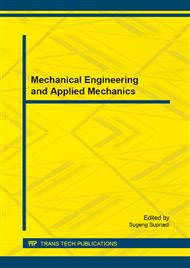p.57
p.63
p.71
p.77
p.83
p.89
p.95
p.101
p.107
Impact Behavior of Apus Bamboo (Gigantochloa apus) Fiber/Epoxy Green Composites
Abstract:
The objective of this work is to investigate the impact behavior of bamboo fiber/epoxy composites. The test was carried out in accordance with the ASTM D5941 Izod impact test standard. Whilst the fiber was obtained from local bamboo the matrix being used is Eposchon general purpose Bisphenol A-epichlorohydrin epoxy resin mixed with Eposchon general purpose Polyaminoamide epoxy hardener. The specimens were cut from nine bamboo fiber/epoxy composite panels. Each panel contains either random or unidirectional fiber orientation of four different volume fraction, i.e. 10, 20, 30 and 40%, of fiber, along with a pure epoxy, without fiber, panel board as reference. According to the adopted standard, the specimens are of prismatic bars of 85 [mm] long × 10 [mm] wide × 5 [mm] thick. Photo macrographs of selected samples were analyzed to describe their failure modes. It was revealed that both the impact strength and energy absorption capacity of the samples increase with the increase of fiber content up to 40%, for both unidirectional and randomly oriented fiber arrangement. In addition, unidirectional fiber composite samples show higher values in both impact strength and energy absorption capacity (0.162 [J.mm-2] and 8.5 [J], respectively) in comparison with those of randomly oriented fiber composite samples (0.144 [J.mm-2] and 7.6 [J], respectively).
Info:
Periodical:
Pages:
83-87
Citation:
Online since:
April 2015
Price:
Сopyright:
© 2015 Trans Tech Publications Ltd. All Rights Reserved
Share:
Citation:


